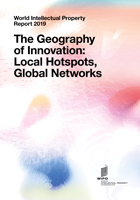The WIPR 2019 examines how the geography of innovation has evolved over the past few decades. Drawing on millions of patent and scientific publication records, the report shows that innovation is increasingly global and intertwined.
The macro analysis of global trends is complemented by two case studies of technological fields undergoing rapid change – autonomous vehicles and agricultural biotechnology.
The report's findings make the case for economies to stay open in the pursuit of innovation.












